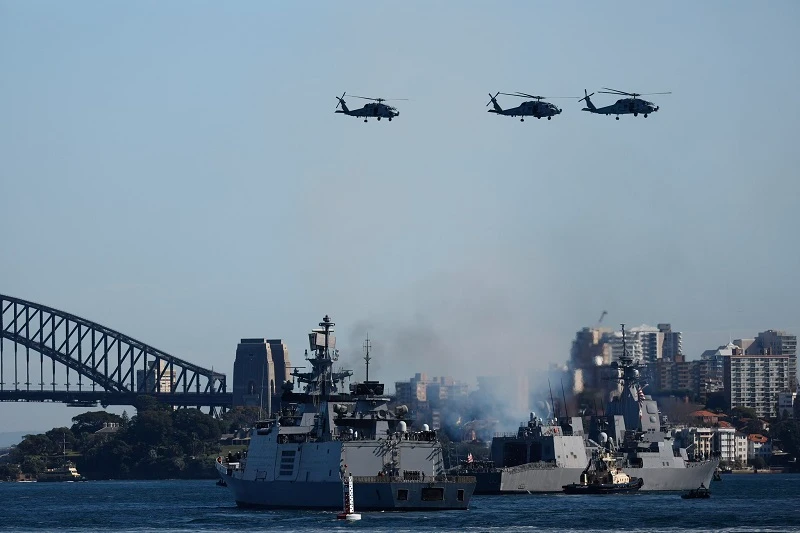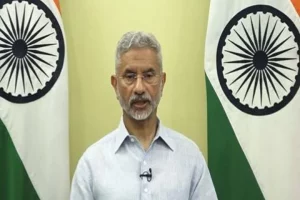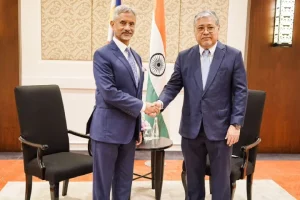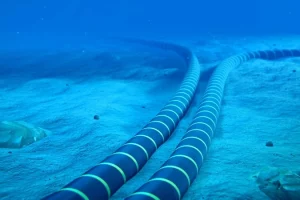Japan has vowed deeper defence cooperation with Quad partners India, Australia and the United States as the warships of the four countries moved to the sea phase of significant Indo-Pacific exercise ‘Malabar 2023’ being held off the coast of Sydney.
The high-end tactical exercise which deepens interoperability between key regional partners is being hosted by Australia for the first time from August 11-21.
Japan, which has sent its Asahi-class destroyer JS Shiranui, the First Surface Unit of the Indo-Pacific Deployment 2023 (IPD23) and the Special Boarding Unit of the Japanese Maritime Self-Defence Forces (JMSDF), emphasised that all four partners respect universal values such as freedom, democracy, and the rule of law.
“We are all comrades who attach great importance to the rule of the international community and stand united against any attempt to unilaterally change the status quo by force. I earnestly hope that the accumulation of these efforts will become the foundation for the stability and prosperity of the international community,” said Admiral Satoshi Saito, Commander of the JMSDF fleet.
#ExMalabar is heading out to Sea
As we move from the Shore Phase of the exercise to the Sea Phase, we take a look at some of the best moments over the last week with our partners and friends, @IndianNavy @jmsdf_pao_eng and @USNavy #StrongerTogether pic.twitter.com/9Bc62ElvUu
— Royal Australian Navy (@Australian_Navy) August 18, 2023
As Quad continues to counter China’s growing influence in the Indo-Pacific, Admiral Saito insisted that JMSDF will maintain readiness and do “everything possible” to defend Japan, while working towards the realisation of a ‘free and open Indo-Pacific’ that will create a security environment that does not allow unilateral changes to the status quo by force.
“Japan contributes to the peace and stability of the Indo-Pacific region and the international community in cooperation with allies and like-minded countries,” he said.
Malabar 2023 also provides another opportunity for the Indian Navy to enhance mutual understanding with the participating navies in keeping with the national vision of Security and Growth for All in the Region (SAGAR).
This year, Indian Navy’s indigenous frontline warships INS Sahyadri, INS Kolkata and P-8 maritime patrol aircraft are participating in the exercise, the harbour phase of which witnessed wide-ranging activities such as cross-deck visits, professional exchanges, sports fixtures and various anchoring events.
The crew of @indiannavy Frigate INS Sahyadri take in the sights of Sydney one last time as they depart for the sea phase of #ExMalabar23, a key regional partnership promoting interoperability between India, Japan, Australia and the United States. 🇦🇺🇮🇳🇯🇵🇺🇸 #YourADF pic.twitter.com/bnIWHPzE5A
— Defence Australia (@DefenceAust) August 18, 2023
“The exercise provides an opportunity to the Indian Navy to enhance and demonstrate interoperability and also gain from the best practices in maritime security operations from its partner nations,” the Indian Navy said in a statement last week.
INS Sahyadri is the third ship of the indigenously designed and built Project-17 class multi-role stealth frigates and INS Kolkata the first of the indigenously designed and built Project-15A class destroyers.
Both ships, built at Mazagon Dock Limited in Mumbai, are fitted with a state-of-the-art array of weapons and sensors to detect and neutralise threats in surface, air and underwater domains.
Various complex and high intensity activities in all three domains of warfare, encompassing anti-surface, anti-air and anti-submarine exercises including replenishment at sea and live weapon firing drills are now being held under the sea phase of the exercise.
#YourADF is hosting @indiannavy and @USNavy P-8 maritime patrol aircraft as part of #ExMalabar23, demonstrating Australia’s enduring commitment to contribute to the security, stability and prosperity of the region. 💪🇦🇺🇮🇳🇺🇸@AusAirForce pic.twitter.com/bLM1yUCucJ
— Defence Australia (@DefenceAust) August 17, 2023
While the Indian, Australian, Japanese, and US maritime forces routinely operate together in the Indo-Pacific, fostering a cooperative approach toward regional security and stability, Malabar sends a strong message of a joint show of strength to realise their common goal of a ‘Free and Open Indo-Pacific’.
It originally started as a bilateral affair between the Indian and the US Navy in 1992 with the Japan Maritime Self-Defence Force (JMSDF) and Royal Australian Navy (RAN) becoming permanent partners as the exercise evolved in scope and partnerships over the years.
@COMAUSFLT Rear Adm. Christopher Smith; @IN_WNC Vice Adm. Dinesh Tripathi; @US7thFleet Vice Adm. Karl Thomas; and @JMSDF_PAO @JMSDF_SDF_ENG Vice Adm. SAITO Akira commenced #Malabar2023, August 10. #USNavy | #AlliesAndPartnerships pic.twitter.com/2SzN3HKPQV
— 7th Fleet (@US7thFleet) August 17, 2023
The Malabar planning and exercise lead rotates each year among participating nations, along with the exercise location to demonstrate the combined ability to exercise across the entire Western Pacific and Indian Ocean. The last edition of the exercise was held in November 2022 off the coast of Japan.
Immediately after the multilateral naval exercise, India and Australia are scheduled to hold their next edition of Australia– India Maritime Exercise (AUSINDEX) which is aimed at strengthening mutual cooperation and enhancing interoperability between the Royal Australia Navy and Indian Navy.
Also Read: With eye on China, India holds slew of military exercises with Quad members




















